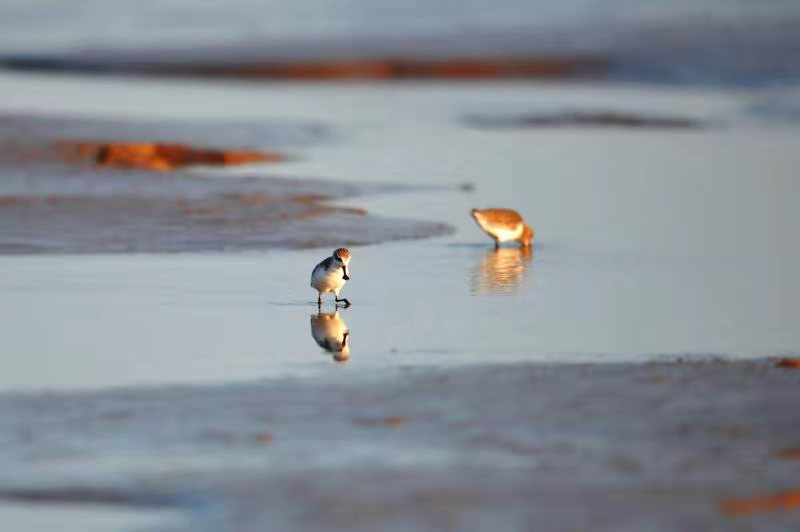On July 5, 2019, the World Heritage Committee decided to inscribe “the Migratory Bird Sanctuaries along the Coast of the Yellow Sea-Bohai Gulf of China (Phase I)” into the World Heritage List, at the 43 session of the World Heritage Convention. This adds China’s total World Heritage sites to 54, which is the highest number of world heritage sites in the world.

Yancheng National Nature Reserve © Chen Guoyuan
The Migratory Bird Sanctuaries along the Coast of the Yellow Sea-Bohai Gulf of China (Phase I) is situated in the largest intertidal wetland system in the world and one of the most biologically diverse. The property is an irreplaceable and indispensable hub for birds migrating along the East Asian-Australasian Flyway, which spans more than 20 countries across two hemispheres from the Arctic to South-East Asia and Australasia. The global importance of the wider coastal area is evidenced by several Ramsar sites, some of which fully or partially overlap with components of the property. Thus, this property is a globally significant example of the shared natural heritage embodied in migratory birds.
The two components of the property are both along the coast of the Yellow Sea: 1) YS1- the Jiangsu Dafeng National Nature Reserve, the southern section and Dongsha Experimental Zone of Jiangsu Yancheng National Nature Reserve and the Tiaozini area (totaling 173,110 ha including a buffer zone of 28,271); and 2) YS-2 the middle section of Jiangsu Yancheng National Nature Reserve (95,589 ha including a buffer zone of 51,785). The total area of the two components is 188,643 ha plus a buffer zone of 80,056 ha.
This site supports some 680 species of vertebrates, including an estimated 415 species of birds, 26 species of mammals, 9 species of amphibians, 14 species of reptiles, 216 species of fish, as well as 165 species of zoobenthos. The property’s tidal flats are of exceptional importance for the conservation of the world’s migratory birds, supporting internationally significant numbers of migratory bird species, including Critically Endangered, Endangered and other IUCN Red List species. The Phase I tidal flats are significant for more than 10% of the East Asian-Australasian Flyway populations and provide critical habitat for two of the world’s rarest migratory birds – the Critically Endangered Spoon-billed Sandpiper and the Endangered Nordmann’s Greenshank, which depend on the tidal flats for their continued survival. The tidal flats also provide important migratory habitat for the Endangered Black-faced Spoonbill, Oriental Stork, Red-crowned Crane and Great Knot; the Vulnerable Chinese Egret, Dalmatian Pelican, Swan Goose, Relict Gull and Saunders’s Gull; and several Near Threatened migratory bird species, including the Red Knot, Asian Dowitcher, Black-tailed Godwit, Eurasian Curlew, Bar-tailed Godwit, Reed Parrotbill, Curlew Sandpiper, Greater Sand Plover, Lesser Sand Plover and Ruddy Turnstone. Other migratory birds that utilise the property include the Eurasian Oystercatcher, Pied Avocet, Grey Plover, Kentish plover, Far Eastern Curlew, Broad-billed Sandpiper, Red-necked Stint, Sanderling, Dunlin, Terek Sandpiper, Saunders’s Gull and Common Tern.

The Critically Endangered Spoon-billed Sandpiper © Chen Guoyuan
The site is located at the highly developed region, and has been regarded as impossible for a world heritage site list, compared to other sites where are often located in remote and much less developed region. Successful inscription of this site in the World Heritage List proves the significant achievement on conservation of the migratory waterbird habitat along Yellow Sea of Yancheng coast, in particular, in the implementation of national ecological civilization strategies. Under the supervision of national governmental agencies, Jiangsu provincial government and Yancheng Municipal government has implemented a series of comprehensive measures to protect and maintain the integrity of the migratory waterbird habitat, including setting up of national nature reserves, provincial-level protected area plots and municipal wetland park, as well as wetland restoration programs.
Inscription of this site has been a joint effort of both national and international institutions and experts. A flyway approach, through serial nomination, set examples that allow wide participation of stakeholders, as well as, allow more sites that contributing to the conservation of the East Asia-Australasia Flyway to be added into the serial nomination. Australia played key role in proposing the drafted resolution, which was fully approved by all the members. The nomination received warm welcome from international communities. It also opens international dialogues and cooperation platform for a flyway approach for biodiversity conservation and sustainable development.

Congratulations to China government for the success of the inscribing Coast of Yellow Sea- Bohai Gulf of China (Phase I)on the World Heritage List © Gao Zhangyuan
More information:
- News release from UNESCO: https://en.unesco.org/news/two-natural-sites-one-china-another-iran-inscribed-unescos-world-heritage-list
- Document of 43rd session of the World Heritage Committee: http://whc.unesco.org/en/sessions/43com/?from=groupmessage
Produced by CGTN




